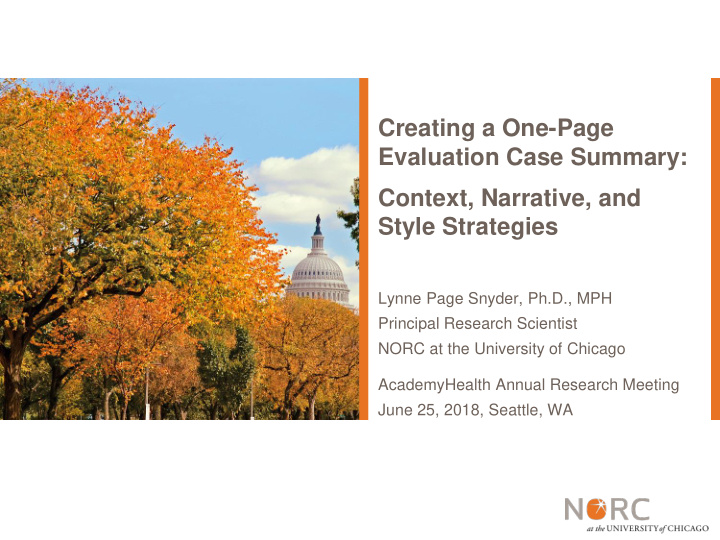



Creating a One-Page Evaluation Case Summary: Context, Narrative, and Style Strategies Lynne Page Snyder, Ph.D., MPH Principal Research Scientist NORC at the University of Chicago AcademyHealth Annual Research Meeting June 25, 2018, Seattle, WA
Overview Challenge = reporting that speaks to its audience Audience: who are they and what are their concerns? Context: framing the story Narrative: for CMMI evaluations, writing about numbers Style: guidance for drafting Example: one-page visual case summaries for first-round Health Care Innovation Award (HCIA) evaluation For more information… Acknowledgments: Health Care team at NORC; Mitali Dayal (CMMI). 2
As LBJ Once Said, “A Range is for Cattle,…” Source: Kat Jayne from Pexels. 3
“Give Me A Number.” Source: Ryan McGuire, https://gratisography.com/. 4
One Page Case Summary for HCIA Evaluation Evaluation of first-round Health Care Innovation Award (HCIA), High-Risk/Patient Targeting Portfolio Range of models Shared focus on highest-risk beneficiaries (Medicare, Medicaid) Mixed methods Client = CMMI The ask = one page visual case summary for each of 23 cases (awardees), akin to a briefing document Constraints : time, budget, production resources (software), statement of work (deliverable specifications) Flexible design to enable consistency across diverse cases 5
More About Goals for the One- Pager… Intended to convey part of a report, rather than be summative or comprehensive Free-standing rather than a preview. Audience likely will not read the report and may use the one pager to make a decision Informed by substantial literature on how to transform evaluation reporting from chore (and bore) to engaging and effective communication 6
What Our Evaluation One- Pager is not… Data visualization or infographic (greater reliance on text) Dashboard (one-time, not intended for update) Peer-reviewed article (less standardized) Social media post (audience = client) 7
Audiences Policy influentials & decision makers Media & Contracting social media Representative, Client Patients, What does our audience most families, & want to know? Health caregivers plans & payers Health care: clinicians, practices, hospitals, skilled Congress, the State & local nursing facilities courts, executive government, branch agencies civic groups 8
Context That the Audience Sees Define the situation What do we know? What don’t we know? What do we assume? Analogies: What is similar? What is different? Identify decision makers’ concerns What’s the objective? What’s the story? Timeline? The facts? What are the options for action? What is feasible for now? What expectations about causes and effects make certain options preferable to others? What new evidence might change or challenge a presumption? Add context: people and organizations as actors moving through time Source: Neustadt & May, Thinking in Time 9
More About Narrative: Telling a Story Using Numbers “Good statistics involves principled argument that conveys an interesting and credible point.” Making comparisons and explaining basis for same Testing claim(s) Respecting chance (null hypothesis) What makes an argument persuasive? Effect size Narrative detail and style Generalizability Being sufficiently important and compelling to change minds Credible Sources: Abelson, Statistics as Principled Argument 10
Writing About Numbers For multivariate analysis: Set context Choose examples and analogies Tailor vocabulary to audience Decide whether and how to use text, tables, and/or figures Interpret number(s) in the text Specify both direction and size of association between variables Describe overall patterns, illustrate with examples, and note exceptions Sources: Miller, Chicago Guide to Writing About Multivariate Analysis 11
Style: Best Practices for Reporting and Visualizations Graphics Keep visuals simple (images, graphs) Reduce clutter Refer to visualization checklist(s) Type Communicate through font style and sizes Develop a style sheet Color Keep the scheme simple Plan for 508 compliance Arrangement Follow design principles for layout, grouping, use of white space, alignment Present no more than 5-7 points per section/page Use consistency (and breaks from consistency) to convey priorities Source: Stephanie D.H. Evergreen & Ann Emery, Reporting & Evaluation Report Layout Checklist, in Evergreen, Presenting Data Effectively 12
Big Decisions about One Pager Frame/Context = COR, CMS front office Narrative = modest and limited positive findings on promising models findings based on data from interviews/site visits, program documents, and claims analyses include multivariate regression models, difference-in- differences, sample surveys, themes in qualitative data Style = free-standing, selectively comprehensive Importance of client review (akin to pretest) 13
What’s on the One -Pager? Basic information About awardee: awardee name, summary description, classification of model type About cooperative agreement: award $$, performance period, reach, populations served, data sources for evaluation Evaluation Domains 14
Basic information Key findings Secondary findings
Footnote
Key findings
For more information, Robert P. Abelson. Statistics as Principled Argument . Hillsdale, NJ: Lawrence Erlbaum Associates, 1995. Robert E. Stake. The Art of Case Study Research. SAGE Publications, 1995. Ann Emery. Website on Information Design, at http://annkemery.com/ . Stephanie Evergreen. Presenting Data Effectively . SAGE Publications, 2014; and website, Evergreen Data: Intentional Reporting and Data Visualization , Source: Kat Jayne from Pexels. at http://stephanieevergreen.com/ . Jane E. Miller. Chicago Guide to Writing about Multivariate Analysis , 2 nd edition. Chicago: Univ. Chicago Press, 2013. Richard E. Neustadt and Ernest R. May. Thinking in Time. The Uses of History for Decision Makers . Free Press, 1988. NORC at the University of Chicago. HCIA Complex/High-Risk Patient Targeting: Third Annual Report . 2017. At https://downloads.cms.gov/files/cmmi/hcia-chspt-thirdannualrpt.pdf . 21
Lynne Page Snyder, Ph.D., MPH snyder-lynne@norc.org Office: 301.634.9569 Cell: 301.520.1809 Thank You!
Recommend
More recommend